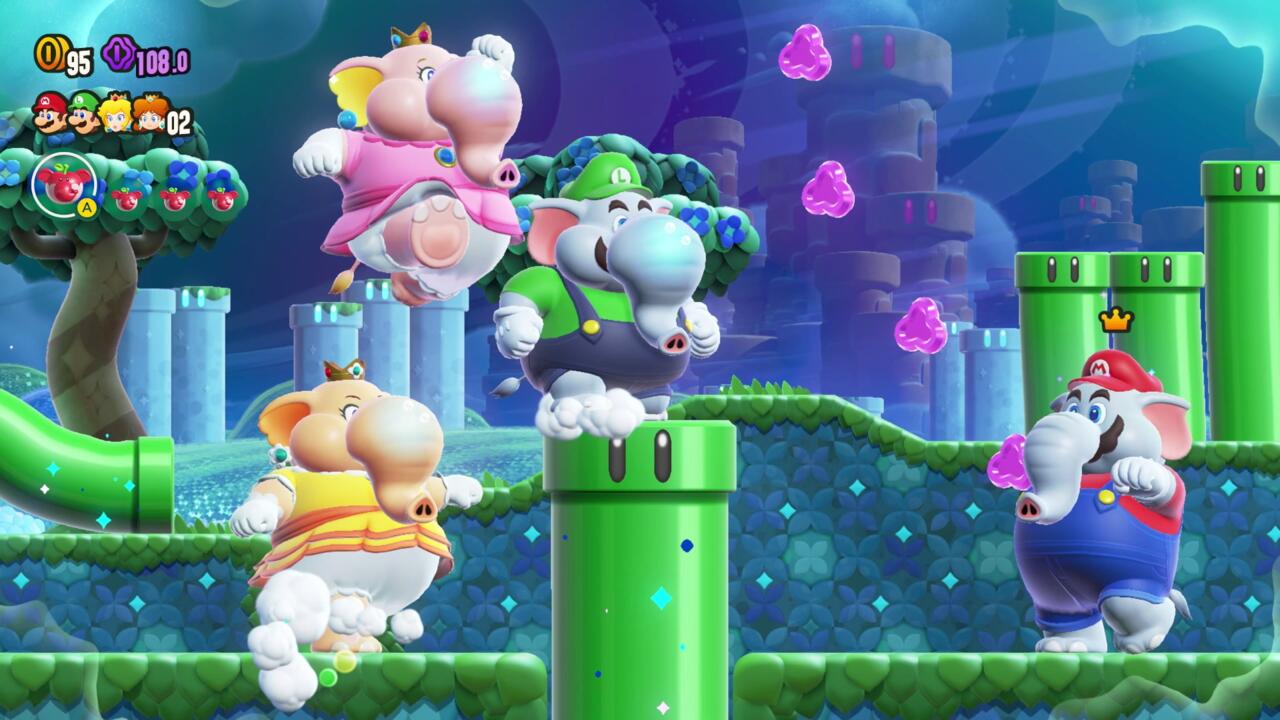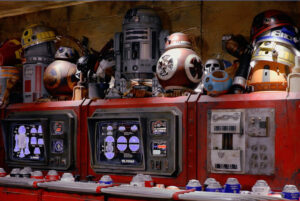Whether Nintendo intended it or not, conventional wisdom tends to sort modern Mario games into something of a mental tier list. The 3D Mario games like Galaxy and Odyssey are the flagship mascot platformers, and 2D Mario games like the New Super Mario Bros. series are somewhat lesser retro throwbacks. Still good, dependable, but less prestigious. It’s after years of 2D games languishing in understudy status that Super Mario Bros. Wonder takes center stage–and it delivers such a knockout performance that it makes the argument, implicit or otherwise, that 2D Mario games can be just as vital to the medium as their 3D siblings.
In essence, the Wonder effects that lend Mario Wonder its title can be likened to the planetoids of Super Mario Galaxy–a simple, easily understood hook that gave stage designers carte blanche to be as inventive and strange as they’d like, constantly reinventing the mechanics and subverting expectations. The result once again is a game filled to the brim with delightful little surprises, like unwrapping a series of gifts made just for you, the discerning fan of Mario platforming.
Those Wonder effects extend from the story, which is loose and unobtrusive. Mario and his pals are visiting Prince Florian of the neighboring Flower Kingdom, who’s keen to show off his kingdom’s greatest treasure, the Wonder Flower. But Bowser crashes the diplomatic event, naturally, and steals the Wonder Flower, transforming himself into a living, floating castle that towers over the kingdom and corrupts everything inside. Premise secured, Mario and company rush to the rescue. The exact scientific effects of Wonder Flowers are never properly explained, but we get the gist well enough: It changes reality in huge, often unexpected ways.
That story premise effectively writes Nintendo a blank check for creativity, allowing any flight of fancy to take place for exactly as long or short as it needs to find the fun. In doing so, it recaptures the unpredictable dream-like logic that made the original games so memorable.
One moment, you’ll be jumping and spinning your way through a traditional Super Mario stage, and the next you may be transformed into a Goomba and hiding from carnivorous creatures that eat Goombas, or seeing yourself only in silhouette, or bounding along to a rhythmic dance. Some of these are genuinely challenging, while others that are played as a cute joke that provide a quick breather. You never quite know what’s coming next.
Very occasionally, a Wonder effect will repeat itself, but this is typically an effect that can support multiple stages. The one memorable exception is very early in the game, when two Bulrush stages follow closely after each other. These stages have you riding on the back of a stampeding herd, and it’s a fun gag the first time, but I will admit I felt a little nervous at the repetition coming so early in the game. If they’re already repeating ideas, maybe there’s less inventiveness than I’d hoped? Luckily that fear abated as I explored further and came across the multitude of varied Wonder effects and stage types.
The variety is aided by the new setting, which also grants the opportunity to come up with tons of new enemy types that fit right into Mario’s traditional visual and gameplay aesthetic. We get the return of familiar favorites like Goombas and Boos, along with loads of inventive new additions. Condarts are fast, razor-beaked flyers that charge straight towards you and then stick into the ground or wall. Hoppycats are dangerous spike-shelled foes that jump whenever you do, requiring you to think through your approach more carefully. Mumsies are mummy-like creatures that are invulnerable unless you approach them from behind and give their dangling wrapping a good tug, at which point they unravel into nothing. The list goes on and on.
What’s most surprising is that, despite the new enemy types and constant sense of surprise provided by the Wonder Flowers, Super Mario Bros. Wonder never loses its identity as a Mario game. The platforming is as sharp as ever, and the level design functions as a great Mario game even when you miss or choose not to pick up a Wonder Flower. The craftsmanship of the level design shows in the little touches, like how watering one of the kingdom’s many magical flowers will make its petals flutter along the wind, awarding you with coins while also subtly drawing your eye toward points of interest.
The handful of new power-ups similarly fit right into Mario canon. The headliner is the Elephant power-up, which makes Mario and his friends jumbo-sized and grants them extra strength and the ability to gather and spray water with their trunks. The Bubble power-up, which lets you trap enemies or create poppable platforms to jump on, feels like such a simple-done-well concept that it could have existed in Mario for years. My personal favorite was the Drill Suit, which lets you dig underground or even into the ceiling, burrow to a new point, and then pop up under an enemy or near a hard-to-reach item. It excels as both a defensive and offensive tool and aids in exploration–plus the swirly pattern on Peach’s dress is just fashionable.
All of this would be the strongest outing for a 2D Mario game in years, but then Mario Wonder builds even more on top of it. A wide array of Mario’s cast of characters are represented and playable, letting you play as Mario, Luigi, Peach, Daisy, Yellow or Blue Toad, Toadette, several Yoshis, and Nabbit. The Yoshis and Nabbit are invulnerable to damage, making them good starter characters without needing to default to a menu option or turning on “Easy Mode” for younger kids.
However, Mario’s friends are without their trademark abilities that originated in Mario 2, which may throw some longtime fans from a loop. Luigi lacks his high-reaching flutter-jump, and Peach can’t float-jump. Playing as these characters without those movement abilities felt a little off, and this does have the effect of flattening each character into an identical playstyle. There is no actual gameplay difference between, say, Toad and Luigi, and that can be hard to get used to. It seems aimed at putting everyone on an even playing field, though, and it works well enough.
The story premise effectively writes Nintendo a blank check for creativity, allowing any flight of fancy to take place for exactly as long or short as it needs to find the fun.
In place of distinct character abilities are Badges, effectively giving Mario and his friends a light equipment system. This is where you can equip a “Floating High Jump” badge that emulates the flutter-jump, for example, so if you want to equip that and play as Luigi, you can recreate the feeling. (There is no Peach float-jump badge, though, as far as I’ve found). Badges come in three varieties. Action Badges, like the Floating High Jump, change your actual gameplay behavior in some notable way, while Boost Badges give you some passive benefit. Safety Bounce, for example, provides a one-time save if you fall into a pit or spikes, while Coin Reward grants you coins whenever you beat any enemies. Rare Expert Badges change the game in significant, challenging ways with bigger gameplay effects than the other two varieties. You can only equip one badge at a time, and the game lets you hit a “Prince’s Choice” button to get advice on what badge might be the best fit for a new stage. Altogether, these create a playground of different styles that you can customize to your liking. Some badges come down to personal preference and there’s usually one or two that will make a stage easier, but you can also challenge yourself by replaying with a badge that makes the stage even harder, or use a badge to turn on “!” blocks that might uncover new secrets. Discovering all the permutations invites replayability and exploration.
That customization does come with one important caveat. In local co-op, you can only equip one badge at a time for all characters, which means you each have to commit to a single playstyle or power that two players may not agree on. This would seem to be for game balance, except that the rule doesn’t apply to online multiplayer. When partnering with friends over the internet, you can each equip your own Badges to suit your preferences or even brainstorm creative combinations. Given that, it’s strange that local co-op feels comparatively hampered.
In fact, the online multiplayer in Super Mario Bros. Wonder is thoughtful and well-designed throughout, which is surprising for a series that has often treated online play as an afterthought. You can join up in a lobby and play through stages together or just venture off on your own. If you do join the same stage you can work on conquering it together or trigger a speedrun-like race to complete the course first. It all feels modernized in a way that Mario has, traditionally, fallen short.
And as well-crafted as the online multiplayer is, the standout for me was the suite of new online features that enhance the experience even when you’re playing solo. You have access to standees, and collecting these is one use of the in-game coin economy. You can lay down one standee anywhere in a stage as long as you can duck and hit X there, and then your standee will populate into other players’ games. You can use this to drop a hint about hidden secrets or just provide a respite to other players. That’s because if you die in a stage, you turn into a ghost and can revive yourself by touching a nearby standee–just like how in multiplayer you can do so by touching another player. So it behooves you to leave standees in helpful places, and every time they get touched, you earn Heart Points to show what a helpful player you are.
Playing while connected to the Internet also means you’ll sometimes see the shadows of other players wandering through the stage, which can assist you in figuring out a tricky platforming puzzle. This is best exemplified in the new Search Party stages, where you need to find five hidden coins. The standees and shadows can help point you in the right direction, making for an asynchronous puzzle-solving experience that feels great. If you’d rather figure out the solutions yourself, of course, you can always just disconnect and those ghosts and standees will disappear.
Search Party is one of several new stage types that mix up the traditional platforming stages. You’ll also find Badge Challenge, where you earn a badge by proving you understand how to use it; KO Arena, a timed stage that awards flower coins based on how fast you can take down rooms of varied enemy types; and Break Time, a quick, less-than-a-minute jaunt of some random minigame or task.
All of these different stage types are littered through an overworld that lets you freely roam to discover secrets and, mostly, take on the stages in any order you choose. The whole world feels alive and engaging, encouraging exploration and replay to uncover all the stages, Wonder effects, shops, and more.

Gallery
And then, there’s a surprising level of craft and care put into the presentation. Even the visually dull New Super Mario Bros. series has looked pretty solid, but Super Mario Bros. Wonder looks downright incredible, with attention paid to facial expressions and animations, along with backgrounds and stage elements with bright confectionary colors that pop right off the screen. Some moments are visually arresting, which is more than I’ve been able to say about a 2D Mario game in some time. Special attention is also paid to audio, especially via a running commentary provided by the talking flowers littered throughout the kingdom. These chatterboxes might provide hints or just crack a joke about some wild new enemy or Wonder Effect. This was a risky choice given Nintendo’s checkered history with chatty sidekicks, but the flowers are genuinely funny, largely unobtrusive additions that help steer the player in the right direction–sometimes literally.
Super Mario Bros. Wonder is a bold choice for a name. It plants a flag in the ground that suggests anything less than a constant sense of awe and delight will be a failure by its own terms. But then, surprisingly, Mario Wonder rises to the challenge and the result is a modern classic. The Wonder effects are the marquee feature, and for good reason, as they serve as a springboard for a cornucopia of creativity. But it’s the smart and thoughtful choices around new power-ups, badges, online multiplayer, and visual flair that cement it in Mario canon. This is the rightful successor to Super Mario World, and hopefully, will serve as a touchstone for 2D Mario going forward.























